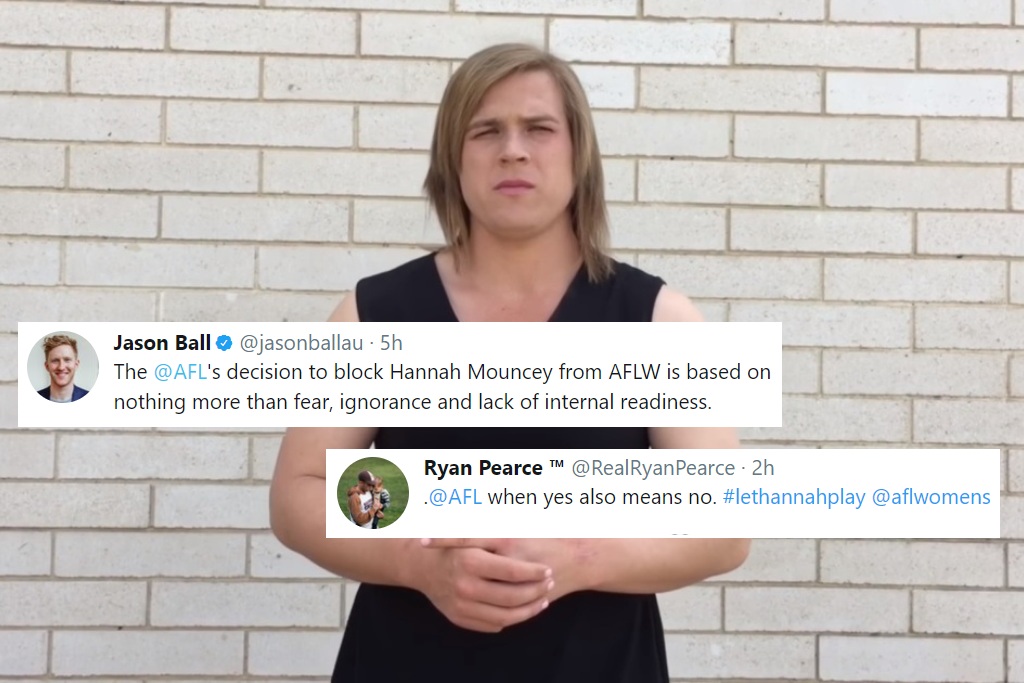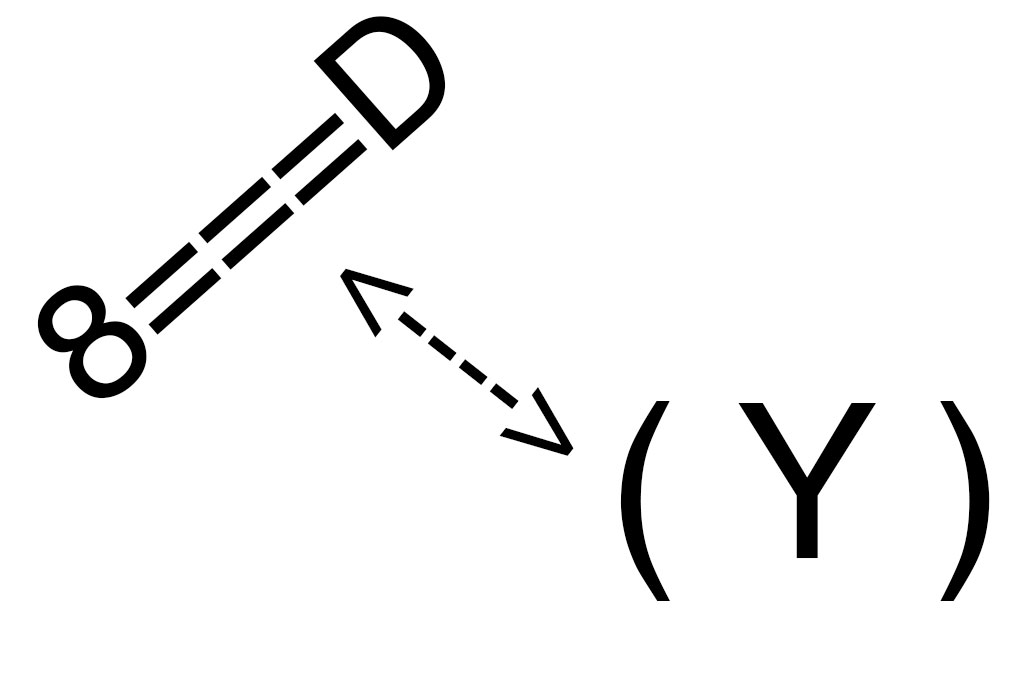Take It From A Trans Person: It’s Bullshit That Hannah Mouncey Isn’t Eligible For The AFLW
Let's debunk all the terrible arguments going around.

Yet again, a transgender athlete has been deemed ineligible to compete in women’s competition. Yesterday, the AFL announced that trans player Hannah Mouncey would be unable to nominate for selection in the 2018 AFLW draft, with AFL Media’s Lee Gaskin reporting that Mouncey’s “physical disparity” giving her an “unreasonable advantage” was at the root of the decision.
The AFL was relatively tight-lipped on the specifics behind the judgment. They explained that their decision was based off “information provided by Hannah, as well as the available data on transgender strength, stamina, physique along with the specific nature of the AFLW competition”. For the record, Mouncey easily meets the International Olympic Committee’s guidelines for transgender athletes’ eligibility — comfortably sitting below the 10 nanomole per litre requirements around testosterone levels.
This is, unfortunately, not a particularly new controversy. As long as trans people have been competing in organised sport, there have been people expressing their dismay at the supposed “unfair advantage” trans women have over their cisgender counterparts. In contact sports such as boxing it’s particularly depressing. Trans MMA fighter Fallon Fox, for instance, has faced a consistent onslaught of vile commentary over the past few years, with her involvement in the arena regularly framed as ‘a man beating up other females’.
Despite being given the all clear from the Association of Boxing Commissions, those in the field such as UFC commentator Joe Rogan are quick to call foul whenever Fox wins a fight, as if it’s unfathomable that her prowess could be the result of hard work and dedication the way we assume it is for basically any other athlete.

For transparency’s sake, I am not a professional in the area of sports science. I’m not a dyed-in-the-wool footy obsessive either, much more of a ‘casually watch a game over a pint’ type of gal than a ‘sell my organs on the black market for front row finals tickets’ one. What I am, however, is a trans person who has spent several years taking hormones, tracking every tiny change in my body and physiology, spending hours reading the available research about how hormone therapy affects a trans person’s body, and generally being a complete nerd about this sort of thing.
I know we’re reluctant as a culture to believe that a trans person’s lived experience is a credible source of information about, you know, our own bodies — so it’s worth noting that the hard science is actually on the side of trans people here too. The assumption that vaguely throwing around the word ‘biology’ a few times is argument enough to deny trans people from competition is contradicted by the fact that existing data actually points in the opposite direction. With that in mind, there are a few myths that need to be debunked.
It’s actually more difficult for trans women to maintain the same muscle mass as cis women.
The first is that trans women athletes have more muscle due to their bodies producing more testosterone than cis women’s. This is inaccurate given that, after the two years of hormone replacement therapy it takes for the body to be considered as having ‘changed’ sex, trans women’s testosterone levels are greatly reduced — they’re often to those equal or below cis women’s. As such, it’s actually more difficult for trans women to maintain the same muscle mass as cis women.
The second myth is that trans women’s bone structure and density greatly puts them ahead of cis women. Much like its effects on testosterone and muscle, after a couple of years, hormone therapy for trans women negates any significant disparity in bone density and structure.
The research backs this up. In 2015, the first ever study of trans athletes demonstrated that, when trans women experience a suppression of testosterone as a result of undergoing hormone therapy, there is a substantial decrease in muscle mass and bone density. Published in the Journal of Sporting Cultures and Identities, the study concluded that, primarily as a result of their greatly reduced testosterone levels, trans women “[lose significant] strength, speed and virtually every other component of athletic ability” and that their endurance capabilities align with those of cisgender women.
Dr. Eric Vilain, director of the Institute for Society and Genetics at UCLA threw his support behind Fallon Fox back in 2013. Vilain explained that trans women “have significantly less muscle strength and bone density, and higher fat mass, than males”. If you’re not going to listen to what a trans woman has to say about all this, you could at least listen to a literal doctor.
Ignoring the data for a moment, is it possible that Mouncey could have an advantage over other players if she were to compete due to her height and weight? Well, yeah. However, it has nothing to do with her being trans.
Here’s the thing: women, cis or trans, come in all kinds of different shapes and sizes and that’s kind of just how we’ve collectively agreed that sport works. All elite athletes, in some way or another, have a specific advantage over other players. There is such a significant variance in athletes’ body types, bone density, muscle mass and so on that if you’re going to disqualify trans women based on these distinctions, why stop there?
Is the AFLW planning on imposing the same arbitrary restrictions on cisgender women? Do we chalk all women’s victories in competitive sports up to their height? Muscle? The amount of testosterone in their body? If a trans woman competes against you and comes out on top, could it be the case that… she’s just better than you?
tall people now banned from AFL sorry pic.twitter.com/gAGXTT1N11
— freya ? (@freyalogann) October 17, 2017
Ultimately, in the face of overwhelming data and rulings by peak sports bodies, the argument that trans women shouldn’t be allowed to compete in women’s sport really only stacks up if you’re going under the assumption that a trans woman is a man. And, well, that’s transmisogyny and, biologically speaking, it’s complete bullshit.
The AFL and any other sporting body that denies trans athletes access to the sporting arena can pretend like these decisions are based on fairness and physical science — but they’re not. In actively choosing to exclude a trans woman from competition based on evidence that simply doesn’t exist, the AFL Commission has made a serious, transphobic error in judgement. They’ve reified the structural transphobia that we face in so many domains of public life.
As many have pointed out, this decision comes a month after the AFL threw their support behind same-sex marriage. In a post on social media, the AFL declared they were “committed to equality and diversity” and supported “the rights of all Australians to live, work and play free from discrimination”.
Trans women are women — get over it — and the athletes that are brave enough to fight against transphobia in sport are pioneers. I look forward to the day when they are able to compete without being unfairly scrutinised and cruelly disparaged.
–
If you feel the need to talk to someone after reading this piece (or any other commentary online) you can contact Lifeline 24 hours a day on 13 11 14 or QLife 3pm-12am on 1800 184 527.
–
Allison Gallagher is a freelance writer and artist from Sydney. She tweets about gender and sexuality at @allisongallagher.

